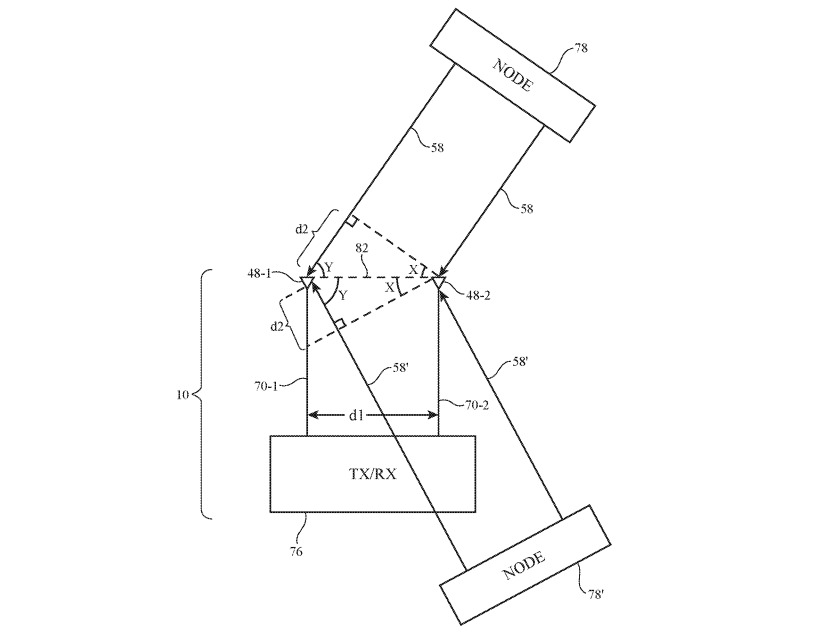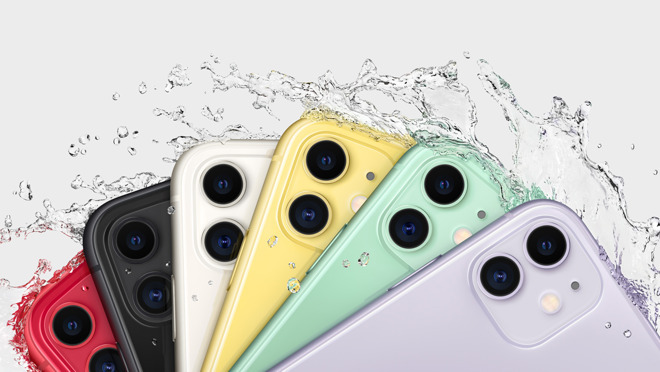Apple's use of Ultra Wideband with the U1 chip in the iPhone 11 and iPhone 11 Pro could go beyond AirDrop and could be used to determine the orientation and motion of a device.
The iPhone 11 and iPhone 11 Pro family of devices both include Apple's U1 wireless chip, which enables the use of Ultra Wideband for a small number of features. The chief usage at the moment is for it to find other iPhone 11 devices nearby that may be available to receive files via AirDrop.
The short-range nature of the system has the potential to be employed for other purposes, such as using UWB pulses to transmit data for use in the Find My app, allowing it to find nearby lost items owned by other people and reporting the location of discovery back to the user.
While similar to Bluetooth 5.1, which offers location detection and range-finding, UWB is able to do so with more precision, and with it comes more potential ways for it to be used.
In a patent application published by the US Patent and Trademark Office on Tuesday, Apple's filing for "Electronic Devices with Motion Sensing and Angle of Arrival Detection Circuitry" outlines some of the more advanced ways it can use UWB.
While it covers how a system can determine the angle of arrival of signals transmitted by a nearby device, namely determining the direction of lost items, it also proposes other refinements that take into account motion. A user looking for a lost item may move around a room, so examining the user's motion and factoring that into angle of arrival readings can help narrow down a desired item's actual location in 3D space.
The filing suggests the control circuity could also determine when the iPhone holder is orienting it in a particular way relative to a nearby device. The system could also determine if the devices are arranged end-to-end or side-to-side, such as next to each other or placed one on top of the other on a table, and to automatically trigger an exchange of data at that time or prompt such action.
While Ultra Wideband could be used to determine the location of other devices to perform a data transfer, the iPhone can still easily switch to another communications method, like Wi-Fi or Bluetooth, to actually perform the transfer itself at a faster rate. This is somewhat reminiscent of previous AirDrop attempts, which used a combination of Wi-Fi and Bluetooth to determine the recipient is nearby, but largely stuck to using Wi-Fi for the actual transfer of data.
Though reminiscent, the more accurate directional nature of UWB makes it more reliable than the earlier methods for ensuring the intended recipient is actually nearby. Knowing the direction and eventual position could allow for features like an AR-based indicator in a real-time camera view from an iPhone showing the position of the desired item, like the rumored device tracker.
 An example of how a moving device can determine the location of a nearby node using two antennas and the angle of signal reception
An example of how a moving device can determine the location of a nearby node using two antennas and the angle of signal receptionThe system itself relies on using multiple antennas, which are put in two different known positions on the host device, though this could be extended to a third. As both antennas will be receiving the same signal broadcast from the secondary device, the difference in time for reception, as well as the positions of the antennas can be employed to triangulate where the signal is coming from in relation to its own orientation.
One proposed claim in the filing involves the use of an actuator that can cause movement in the device between multiple positions. Doing so can allow the antennas to be shifted around, in turn allowing it to determine the positioning of a secondary device relative to it, without relying on outside forces.
Said outside forces would usually entail a human carrying an iPhone around, but in the case of typically static devices, like a HomePod, this could be a movement of internal components holding the antenna.
Apple files numerous patents and applications with the USPTO on a weekly basis, and while the filings do not necessarily guarantee the discussed technologies will be used in a future product or service, they do reveal areas of interest for Apple's research and development efforts.
In this particular case, the filing shows how the U1 chip may actually function, as well as potential improvements Apple could perform to make the technology more useful for iPhone owners.
Apple has also made other proposals involving Ultra Wideband that could enhance HomeKit. One application that surfaced in September suggested the use of UWB in a "modular wall unit system," effectively using the technology in outlets to allow them to be turned on or off remotely, and to determine the location of other connected devices and users, via their carrying of an iPhone.
 Malcolm Owen
Malcolm Owen







-m.jpg)






 Marko Zivkovic
Marko Zivkovic
 Christine McKee
Christine McKee
 Andrew Orr
Andrew Orr
 Andrew O'Hara
Andrew O'Hara
 William Gallagher
William Gallagher

 Mike Wuerthele
Mike Wuerthele
 Bon Adamson
Bon Adamson


-m.jpg)



5 Comments
This is exactly what Apple demoed with the Airdrop feature. The system knows which device the iPhone is pointing at.
But but but just this week people said Apple’s innovation died with Jobs!
Options seem almost limitless.
UWB can track items down to the centimeters in accuracy. This opens up the benefits of Beacons at another level. It should allow for music and video to "follow you" through the home. Allow for HomeKit scenes or actions to be hyperlocal. There will less need to have motions sensors when UWB knows when you walk into a room and even knows what area of the room you're in so that lights or other devices just in your area can turn on.
UWB can actually transfer data faster than USB so there's little need to even switch protocols for data transfer. Clearly Apple is serious about the technology because they've added it to both iPhones and have built their custom chip. Will this UC1 end up in a refreshed Apple TV or HomePod or will see specific external transceivers offered that blanket the room with UWB signals?
I imagine that Apple will find a way to bridge worlds via software to take devices that are Bluetooth or Wifi and connect them to UWB products so that consumers can gracefully upgrade their systems.